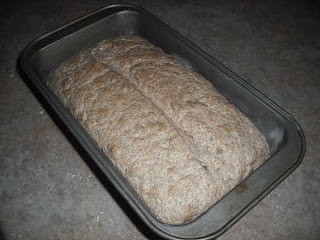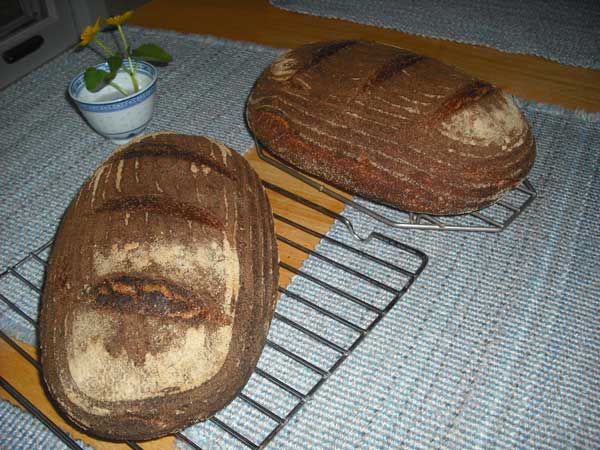Glutton's Rye
Is it possible that one can bake terrible loaves, and even more terrible loaves, and yet still more awful, disgusting, ugly, almost inedible loaves, so often that one forgets what good bread is? Just a question. Now, is that what is happening to me? Or is that what has happened to the rest of the world?
It occurs to me that the fool, the self-righteous and the insane person stand alone in their visions. Well, so do geniuses, but they are so rare as to be discounted. So which am I?
If it were not for the occasional loaf that I give away to a friend -- who then reports that he ate it with gratitude, or that he fed it to his family and they all liked it very much -- I should count myself among the merely silly or the sanctimonious or the mad.
Here are a few sourdough rye loaves that I've baked in bread-tins recently. But I ate them myself, I didn't give these away! Pious mad gluttonous fool.
1. The First two breads with Rye
The smaller of these 2 loaves is a 100% rye loaf made with sourdough and 80% hydration.
The larger of the two loaves was also to have been 100% rye, but it actually contains a bit more sourdough starter, that I otherwise would have tossed away. That starter is made of about 200g of whole wheat at 100% hydration, and it was a few hours past its prime, so quite sour scented. It was not mixed with the rye but with about 100g of whole wheat. And rather than mix that with the rye dough, I decided to use it to line the bottom of the tin, the rye dough sitting atop it. I thought I might be able to differentiate precisely where the crumb of the two doughs mixed, but after the long overnight fermentation, I really couldn't see much of a difference.
Looking at the photos now, I think I can see a slight discolouration of the lower wheaten crumb, but that could be a trick of the light. It really isn't discernible. The overall taste is sour too, and you don't really delineate a difference with your tongue either.
I docked both loaves with a skewer completely to the bottom before baking them, and watched them deflate before putting them in the oven. I'm not sure that was such a great idea, but I have to admit that the crumb was more evenly baked than some other 100% rye loaves I've baked without such docking.
1. The First two breads with Rye
The smaller of these 2 loaves is a 100% rye loaf made with sourdough and 80% hydration.
The larger of the two loaves was also to have been 100% rye, but it actually contains a bit more sourdough starter, that I otherwise would have tossed away. That starter is made of about 200g of whole wheat at 100% hydration, and it was a few hours past its prime, so quite sour scented. It was not mixed with the rye but with about 100g of whole wheat. And rather than mix that with the rye dough, I decided to use it to line the bottom of the tin, the rye dough sitting atop it. I thought I might be able to differentiate precisely where the crumb of the two doughs mixed, but after the long overnight fermentation, I really couldn't see much of a difference.
 |
| the large |
 |
| Maybe you can see a crumb difference, top to bottom. |
Looking at the photos now, I think I can see a slight discolouration of the lower wheaten crumb, but that could be a trick of the light. It really isn't discernible. The overall taste is sour too, and you don't really delineate a difference with your tongue either.
 |
| the smaller |
 |
| 100% rye bread as it stales seems to add thickness to its crust |
I docked both loaves with a skewer completely to the bottom before baking them, and watched them deflate before putting them in the oven. I'm not sure that was such a great idea, but I have to admit that the crumb was more evenly baked than some other 100% rye loaves I've baked without such docking.
2. Another Rye
This next loaf was made with 400g of older whole wheat starter (100% hydration) that would otherwise be tossed. To it, I added 200g of rye flour, and 100g of water. Later I added 7g of salt (2% would have been 8g), and about a cup of sunflower seeds (50g). When adding the salt I also added 50g more water, and mixed all thoroughly.
I have to admit, I held out no great hopes for this bread, made as it was from what would otherwise be some sourdough discard.
This was a small amount of dough for the tin, but I covered it and let it sit overnight in the cool house. In the morning, it had spread out and risen well enough to give me a thin loaf. Just before baking, I spread some old plain Kefir on the top (it had expired a week ago), and I also baked with steam.
 |
| The top of this bread was this burnished, lovely coppery colour, like lucky pennies carried too long in a pocket |
I waited until evening to slice it, and discovered the taste was wonderful, the crust superb. I surprised myself by ignoring thoughts of dinner and gorging myself on a third of this loaf all at once, first with cheddar, then toasted with peanut butter, then a milder cheese (I think it was brie), and then I even made cinnamon toast. At this point, I began to feel quite bloated and disgusted with myself. But I couldn't stop eating it, it was so tasty.
I had a junkie's craving jejunum.
This bread was surprisingly good. I can't decide why, exactly, except I think it must be the kefir crust and the sunflower seeds I added.
Notes to Myself
- The good bread's recipe in a nutshell: • 400g ww starter just past its prime @ 100% hydration
• 200g rye flour
• 100g water + 50g more when adding salt after a short autolyse
• 7.0g salt
• 50g sunflower seeds
Method: Mix, form into a ball, place in a buttered tin, score deeply and let sit overnight. In morning, preheat oven to 450 degrees F, brush surface with expired Kefir (or thinned plain yogurt I suppose), and bake with steam for 40 minutes, turning once at 20 minutes for even baking. Remove to a rack, and let sit several hours before slicing. - Ever noticed how close "gluten" sounds to "glutton"?
- "Gluttony is an emotional escape, a sign that something is eating us."
- Peter De Vries, in Comfort Me with Apples
- What's eating me?












































